Your book on the “long deep grudge” between International Harvester and the Farm Equipment Workers Union is a rich and multilayered history of the rise and fall of American labor and industry where history itself plays a recurring role. Why did you choose to start your book in the late nineteenth century with Cyrus McCormick and the events of Haymarket, and why is the “long deep grudge” an effective metaphor for understanding the epic battles for labor rights you describe in the book?
As labor historians we take it as a truism that present-day struggles have been shaped by past conflicts. We also know that understanding history, as it illuminates the mechanisms by which ordinary people have improved conditions for themselves, is crucial to building and sustaining working class power. But these things are not at all self-evident to everyone else. How we might draw clearer links between past activism and present possibility seems to me one of our more important tasks, and that’s what makes so compelling the conflict between International Harvester (IH), one of America’s founding industrial empires, and the Farm Equipment Workers (FE), which emerged in the 1930s with the rise of the CIO. Both the company and the union remained acutely conscious of the past, though of course the FE leadership and IH management clashed over the interpretation of it. Moreover, as I argue in my book, “no other union was as animated by its own history as was the FE, or more cognizant of how struggles from distant decades laid the groundwork for later triumphs.” It’s thus perceptive to say, as you do, that history is itself a recurring character in The Long Deep Grudge.
Because I also believe it crucial to focus on capital as well as labor, I wanted to explore the contours of class war from both sides of the battle lines. American history offers up no better case study for that than the bitter, deep-rooted contest between IH – once the fourth-largest corporation in the world, controlled through its existence by the McCormick family of Chicago – and the radical, Communist Party-influenced FE.
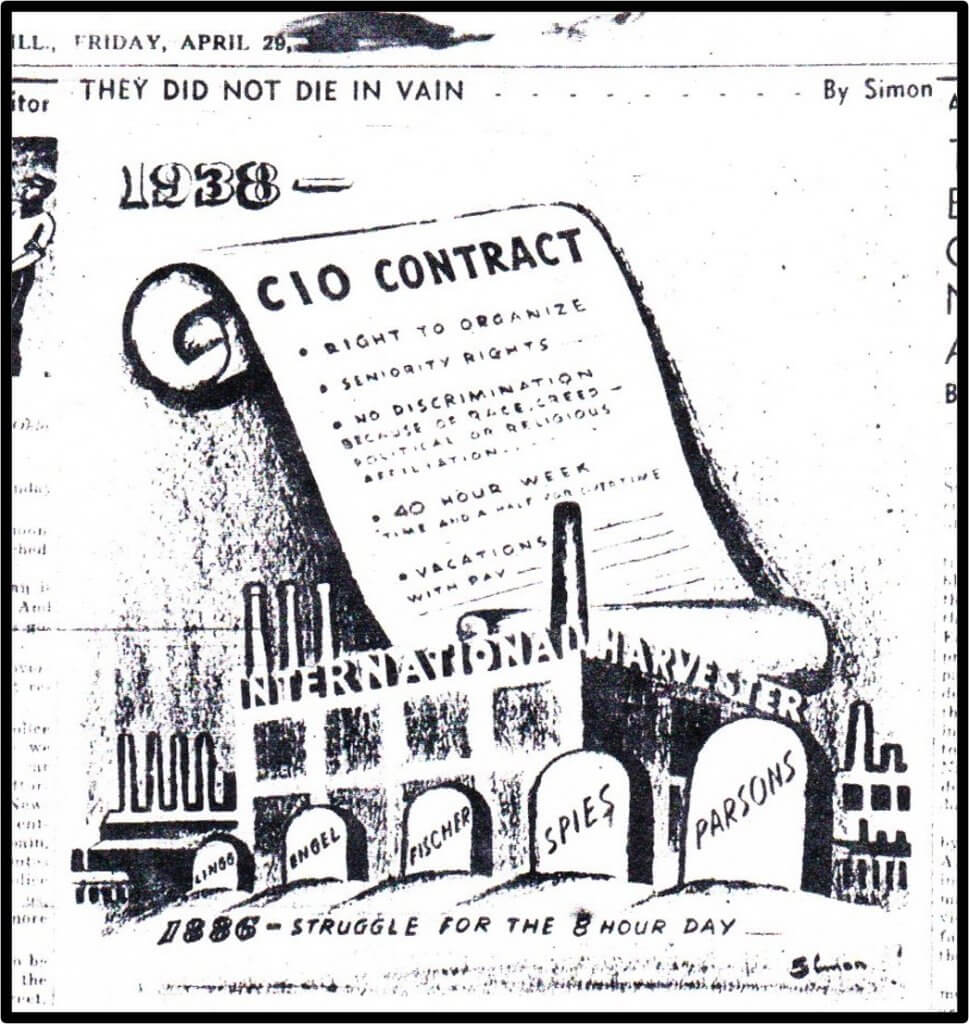
FE leaders made frequent reference to the Haymarket martyrs throughout the union’s existence. This cartoon illustrated an article in the Midwest Daily Record, written by FE leader DeWitt Gilpin, about the union’s 1938 breakthrough victory at International Harvester.
To get at the deep roots of this grudge match required a big sweep. I thus took the story back to the 19th century, to the McCormicks’ pioneering first factory in Chicago and to the transformative events that took place inside it, as skilled craftsmen were stripped of their autonomy, and outside it, as revolutionary rhetoric rang through the city’s streets. During the massive nationwide general strike that had begun on May 1, 1886, it was police violence outside McCormick Works that prompted a demonstration in Haymarket Square. Young Cyrus McCormick II proved instrumental in ensuring that a group of anarchist labor activists were executed for the bombing that took place there that night. In the national crackdown following what came to be called the Haymarket “riot,” the eight-hour day movement collapsed, unions – including those at McCormick Works – were decimated, and radical workers’ movements were utterly destroyed.
But anarchist August Spies, at his trial, vowed “if you think that by hanging us, you can stamp out the labor movement, then hang us! Here you will tread upon a spark, but there and there, and behind you and in front of you, flames blaze up! It is a subterranean fire. You cannot put it out. The ground is on fire upon which stand.”
So my book details how those embers, tamped down after Haymarket, blazed up again in the 1930s when the FE organized International Harvester, which the McCormicks’ business had by then morphed into. The title of my book is in fact a reference to the legacy of Haymarket, borrowed from Chicago author Nelson Algren, who wrote in 1951 of “the dark grudge cast by the four standing at the gallows’ head, for the hope of the eight hour day,” and of “the long deep grudge borne for McCormick the Reaper.” The FE leadership frequently invoked the Haymarket martyrs throughout the union’s history, to remind union members of the debt owed those early radicals and to stoke righteous resentment against the cold-blooded McCormicks. Acknowledging that workers carry deep – though sometimes inchoate – grudges against their employers, and finding ways to meaningfully address them, was central to the combative, class-conscious unionism the FE modeled.
After World War II, International Harvester opened a plant in Louisville, Kentucky where much of the events in the second half of your book unfold. Why Louisville? Who are some of the most interesting people you studied in the Louisville local, and what are some of the most interesting examples and findings you uncovered about the culture of unionism the FE created?
IH joined the wave of capital flight that began after World War II, as corporations flocked toward the low-wage, and far less unionized, South. But the FE made the jump across the Mason-Dixon line as well, and began organizing in Louisville well before Harvester began production there. In its organizing drive the FE – as opposed to the other unions that were competing for recognition at the IH plant – made clear that it would fight equally for Black and white workers, a risky strategy, given that Louisville was then still segregated and 85% of Harvester’s employees there would be white, many of them then dyed-in-the-wool racists. But the FE’s commitment to interracial unionism was personified by the two men who led the campaign: Vernon Bailey, a white CP member and veteran of numerous union drives elsewhere, and Fred Marrero, a Black Louisville resident and outspoken advocate for the African American community. Precisely how Bailey and Marrero crafted their organizing drive, and won the battle for recognition in 1947 by a whopping majority, is detailed in my book.
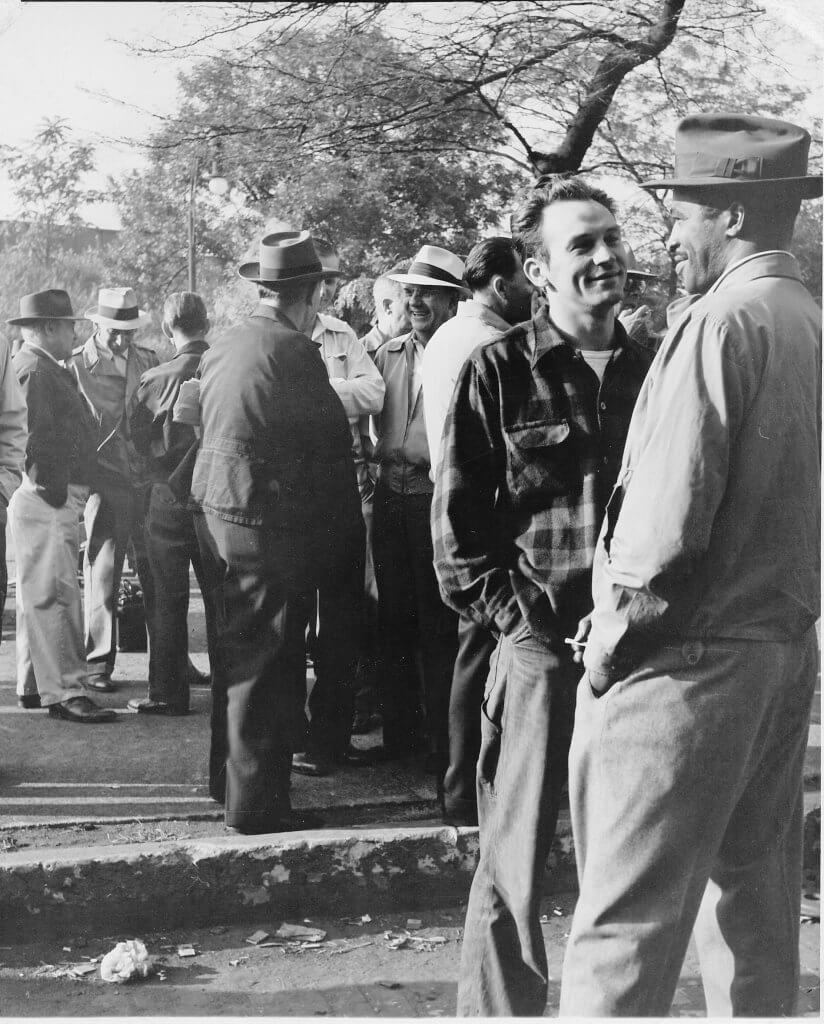
The FE maintained an extraordinary commitment to interracial unionism, especially since the membership was about 80% white. The solidarity engendered through continual workplace struggle encouraged deep personal ties, as this FE picket line photo suggests.
But that was just the beginning, as Local 236 in Louisville came to represent, I argue, “the most perfect embodiment of the FE’s ideology.” Part of this was quantifiable, as the radical FE’s commitment to shop-floor militancy, including a liberal reliance on walkouts to win grievance disputes, was on full display at the IH plant in Louisville, where “wildcat” strikes became commonplace. But it was also evident in Local 236’s adherence to what could be called “lived solidarity” – the belief that day-in, day-out collective struggle against management, involving Black and white workers together, was essential to undermine racism and forge the class cohesion necessary to take on rapacious capitalists. The combative, and extraordinarily united, Local 236 membership, moreover, took their fight for equity beyond the plant gates and into the community, challenging segregation in Louisville’s parks, hotels and hospitals. I illustrate all this through the stories of various Louisville FE members, including Jim Wright, who was Black, and Jim Mouser, a white man; both became leaders within Local 236 but also close friends who regularly spent time together outside of work, often with their families, at a time when interracial socializing in Louisville was a rarity. How the FE’s linkage of workplace militancy and antiracism succeeded at transforming Harvester workers in Louisville, often in profoundly personal and heartfelt ways, is a moving – and timely – story, I’d say.
Your father, DeWitt Gilpin, plays a significant role in this history. What were some of the challenges you faced researching and writing a history with such personal connections?
As I indicate in the book’s preface, when I was growing up my father was a UAW staffer, and I knew only dimly about his previous role in the leadership of the FE. He died when I was in college, and sometime after that I began researching the FE, for a senior thesis in college and then as the subject of my dissertation which I completed in 1992. So while my father was the impetus for my interest in the FE – about which little had been written before I took it up – I hadn’t talked directly to him about his experience with the union while he was still alive. Of course there are a thousand questions I now have that I wished I had asked him, but ironically it’s quite likely that had he lived longer I might not have focused on the FE at all. He was a man of strong opinions and direct knowledge of the history I covered and I’m not sure I could have written about something so close to him while he was around to review it.
There are privileges attached to being personally connected to a subject, especially because, while papers related to the FE can be found in various archives, no repository expressly devoted to the FE exists. My father was not a packrat and my family lived in a Chicago apartment, so alas I found no treasure trove of old documents stored in an attic or anything of that sort. But he had saved some literature from his FE days which didn’t exist elsewhere. Because of my family connection I was also able to conduct interviews with former FE leaders, some of whom, particularly those with Communist Party ties, would not have talked to anyone else. Many of those people also shared with me their own documents related to the FE, which proved critical in constructing the union’s history. Fairly early on I also requested my dad’s FBI and military intelligence files, and also had his file from the Chicago Police Department’s “Red Squad,” one of the longest on record. So my personal FE connection proved invaluable in those respects.
I went to grad school right after college, when I was still pretty young and uncertain about many things. My dissertation hued to standard form and I strove to make it as “objective” and therefore as impersonal as possible. I didn’t pursue an academic career and so never had my dissertation published. When I decided, many decades later, that the FE’s story really needed to be told, I intentionally set out to craft something quite different, and so rather than distance myself from it, in The Long Deep Grudge I embraced my personal connection to the subject. I weaved much more of my father’s story into the narrative, and found that freed me to be more expansive about the many others – FE officials and rank and filers but also McCormick family members, politicians, civil rights leaders, judges, jazz musicians and more – who were involved in the rather epic story I’ve told. The crucial biographical details and the amusing anecdotes that I included not only make The Long Deep Grudge a better read; I believe they make the history more tangible and thus more “true.” So if there are young scholars hesitant to take up topics they have personal connections to, I’d say: go for it. There are particular difficulties to navigate, but that’s the case with anything we choose to investigate. All historians carry a passionate interest in their subjects; it would otherwise be impossible to put in all the work necessary to produce the articles and books. A personal connection to the material simply makes more up-front the reason for that passion.
The CIO purged the FE from its federation in the aftermath of the Taft-Hartley Act for being led by communists. What did it mean, on the ground, to be in a left-led union during the heated McCarthy period?
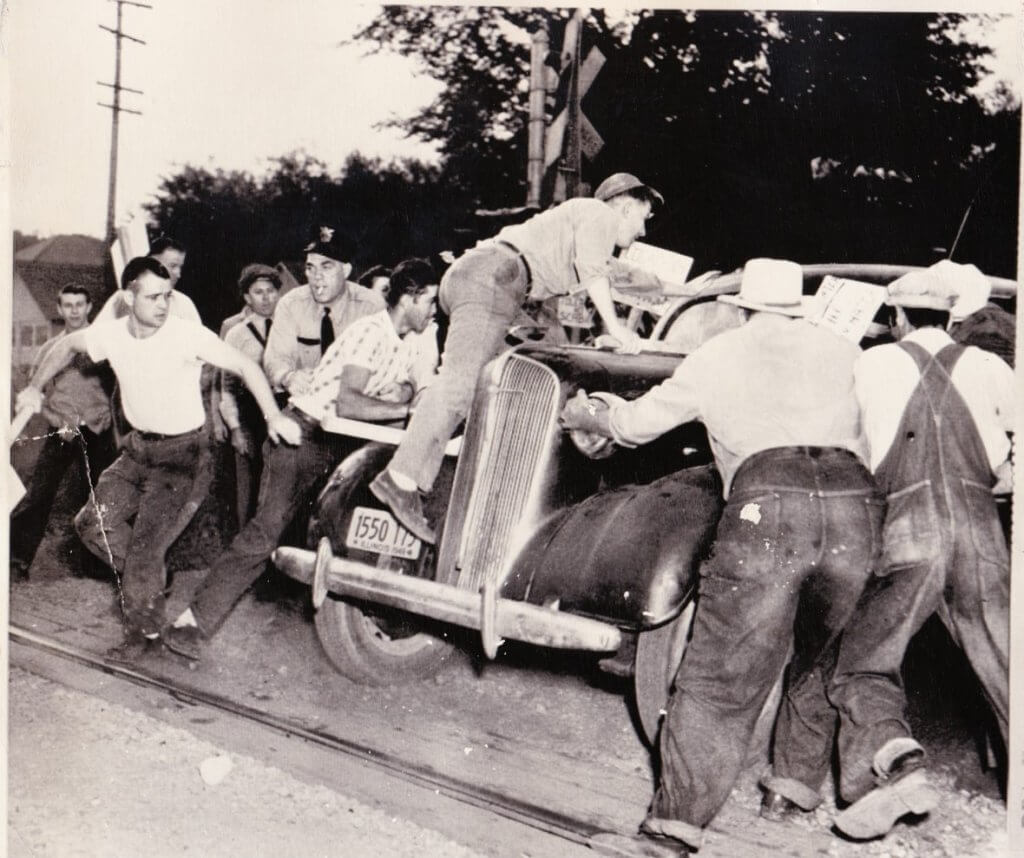
The FE’s combative ethos found expression in the high number of walkouts engaged in by union members; from 1946-1954 there were over one thousand work stoppages at IH plants represented by the FE. Here FE members in East Moline, Illinois, react unfavorably to an effort to cross their picket line.
Just what it meant, on the ground, to be a member of a Communist-oriented union is one of the main themes of my book. For a long time, the assumption among scholars, regardless of their political leanings, was that the high-level dispute in the post-WWII era between the left and right wings of the CIO had no particular bearing on those things, like collective bargaining agreements, that affected union members on a daily basis. But what I contended years ago in my dissertation, and have expanded on in my book, is that the Marxist framework FE leaders embraced in fact directly affected the contract terms they fought for and the shop floor ethos they promoted. The FE leadership’s bitter feud with the United Auto Workers’ Walter Reuther was jurisdictional on its face but ideological at its heart, as Reuther promoted the “politics of productivity” – the notion that labor and management could cooperate to achieve mutually beneficial economic growth. FE officials had a different idea: “the philosophy of our union,” one of them said, “was that management had no right to exist.” The FE leadership thus sought to limit, rather than augment, corporate profit-taking in ways that found expression in the union’s collective bargaining objectives: opposition to no-strike, productivity pay, and cost-of-living clauses; a preference for short agreements; and most critically, FE contracts provided for exceptionally large steward bodies (as opposed to the UAW’s agreements in the same era) empowered to address workers’ grievances immediately, which in real terms meant frequent work stoppages. For FE members at International Harvester, this translated into high pay rates, but also more control over what sort of work they did and how fast they were required to do it to earn top dollar. But exerting this sort of authority also necessitated continual agitation and shop floor disruption. On the other hand, Reuther and the anti-communist labor establishment conceded that pricing, profits and production standards were solely “managerial prerogatives.” In exchange for that loss of control, UAW members experienced less turbulent workplaces along with good pay and benefits. The real costs of that bargain would only become clear by the late 1970s, as the inexorable drive to bolster the corporate bottom line brought on relentless speedup, plant closings, and the mounting immiseration of working class communities.
But while FE members enjoyed better quality of life on the job, as the Cold War got hotter being in a left-led union also meant being subject to an intensifying anti-communist assault from business elites, the press, the government, and the labor movement’s establishment. After WWII Walter Reuther claimed jurisdiction over the farm equipment industry and commenced a series of “raids” on FE locals, and thus the UAW expended considerable resources attempting to organize workers who were already organized. Remarkably, however, despite the red-baiting barrage aimed at the FE by the much bigger and better funded UAW, Harvester workers remained doggedly loyal to the FE, rejecting the UAW’s advances time and again. Despite that endorsement from workers, the CIO expelled the FE, along with a dozen or so other unions, in 1949. One of my chapters is entitled “The Shrinking Realm of the Possible,” as by the 1950s FE leaders and the rank and file found their options increasingly limited. But you’ll have to read the book to see exactly how that played out.
Even though the FE and International Harvester no longer exist in any meaningful way as they did in your history, the history of their rise and fall speaks directly to today. What are the most important lessons for today’s labor movement.
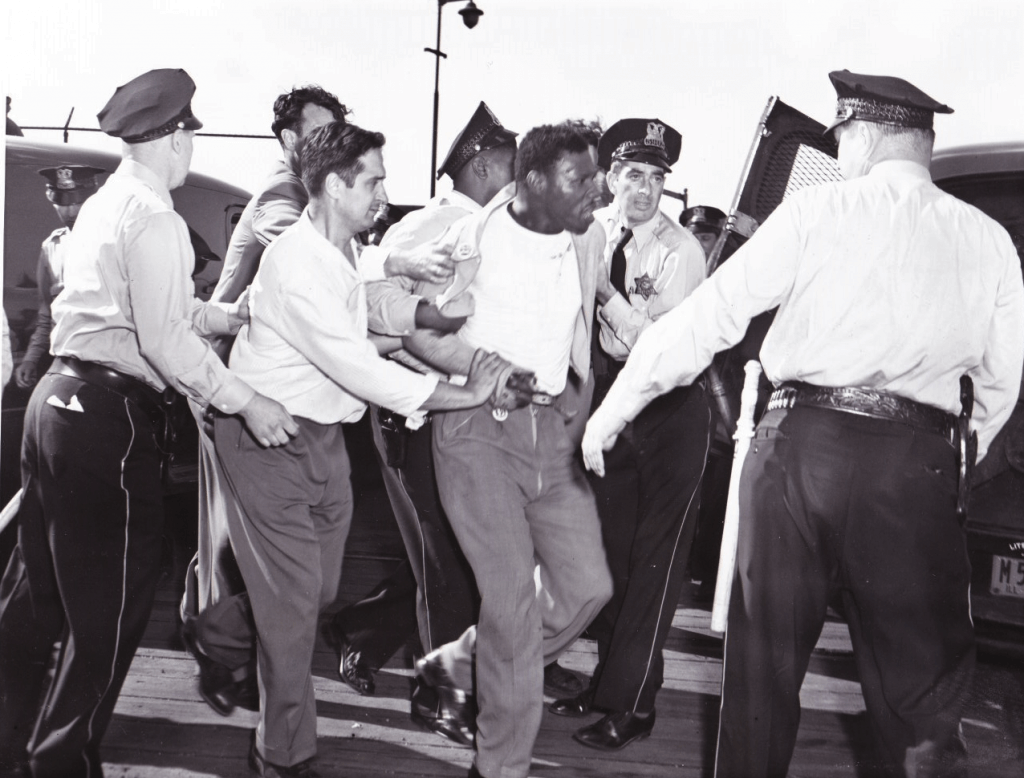
When, in 1952, IH announced its intention to move one of its facilities from Chicago to New Orleans, meaning the loss of nearly 900 union jobs held largely by Black workers, both men and women, FE members responded with a sit-down strike and and physically resisted the company’s efforts to remove machinery from the plant. That confrontation led to the arrest of dozens of FE members, including this one, who required a host of Chicago Police officers to get him into the patrol wagon.
I was motivated in large part to write The Long Deep Grudge because I do believe the FE’s story has relevance for those seeking to revitalize the labor movement. I hope that activists will see connections to their work throughout the story I’ve told, and in the book’s conclusion I underscore what there is of value to be extracted from the FE’s brief existence, so I’ll touch on a few of those thoughts here. One, drawing on what I said above, is that the ideological orientation of a union leadership makes a difference, and by that I don’t simply mean a propensity toward toughness or militancy, as labor leaders of varying political leanings can possess those characteristics – think John L. Lewis, Jimmy Hoffa, or, on many levels, Walter Reuther as well. Yet as opposed to the post-WW II labor establishment, which had shackled itself to the notion that increasing productivity was universally beneficial, the Communist, Marxist FE leadership embraced an understanding of surplus value that made resistance to corporate profit-taking, both during contract negotiations but also every day on the shop floor, an imperative. Thus the union combated management efforts to speed up work and acted on the principle that every worker’s grievance represented “a scream for justice.” The FE could also offer an aggressive challenge to capital flight, as when in 1952 the FE staged a sitdown strike, and battled with police, in response to an IH plan to move a plant from Chicago to New Orleans. So ideology matters, and has both short and long term consequences for union conduct.
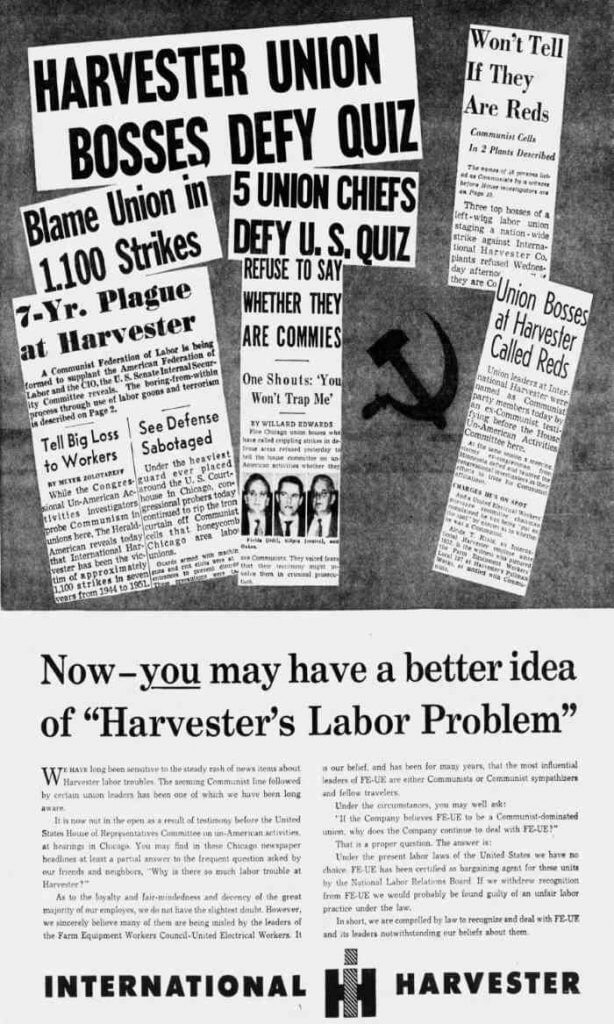
Notoriously anti-union International Harvester, which pioneered many union avoidance tactics that remain standard business practice today, made no effort to hide its antipathy toward the Communist-influenced FE leadership. The company ran ads like this in newspapers around the country during the violent three-month long 1952 IH-FE strike.
We should not underestimate, however, how rocky the going has been, and will be, for those unionists who adhere to the concept of class warfare. My book emphasizes how narrow the path forward for left-wing unionists became, in part because of the concerted opposition they faced from anti-communist labor leaders like Walter Reuther. But make no mistake: all CIO unions, even the most conservative ones, were at best only grudgingly accepted by the ruthless and cunning captains of American private enterprise. I centered my book around the deep-rooted grudge between International Harvester and the FE for a reason, to underscore that capitalists – not other union leaders – have been and remain the real enemy of the working class. The McCormicks were among the most effective of the lot, and organizers today reading my book should have many “ah ha” moments as they recognize that many of the union-busting techniques utilized by today’s corporate behemoths, like Amazon, were introduced long ago by International Harvester. If we want to understand how class conflict really plays out, and how labor might gain an advantage, we must pay close attention to managerial strategy and how those practices have evolved (or simply been rebranded) over time.
In the ongoing class war labor has one formidable weapon at its disposal. The FE’s story – and the long struggle that preceded its founding – underscores the primacy of that core union tenet: solidarity, meaning all-encompassing and regularly-practiced solidarity. The FE’s experience in Louisville demonstrates that even in supremely hostile environments it is possible to break through racist barriers; to do so organizers must be unwavering in their commitment to equality while being both relentless and patient with workers. Not an easy task by any means, but in the FE white and Black workers not only walked picket lines together; they developed deep and abiding friendships that served as the union’s source of strength. African American Frank Mingo, the vice-president of one of the FE’s Chicago locals, said that “the rank and file loved that union.” Solidarity experienced this way – as a marrow-deep sense of class consciousness and communal spirit that overcomes the divisions sown by capital – can have mighty consequences. It has before.
Now that your book is published, what books are you looking forward to read?
I have a lot of catching up to do on recently published labor history, and since noteworthy books keep coming out, that’s a challenge. I also like reading histories that are popular with general audiences, as well as historical novels, as for one thing I am interested in the methods such authors use to keep readers engaged. But I’m also now turning my attention to something that doesn’t involve too much reading: historically-based video games. I’ve never been a game player myself, but my daughters are, and my oldest is employed as a video game producer. Gaming is now the biggest entertainment industry by far, yet when historians – myself among them – consider how popular culture shapes perceptions of the past, we tend to talk about movies or music or television. But students are more likely to have played Call of Duty or Red Dead Redemption than they are to have seen Schindler’s List or Deadwood. So at the moment I’m diving into big-budget AAA games like Assassin’s Creed III, centered on the American Revolution, and also indie games, like the creative Czech game Svoboda 1945. I’ve been surprised by various things – a good portion of the dialogue in Assassin’s Creed III, for instance, is delivered in Mohawk (Kanien’kehá:ka), translated by Indigenous linguists, and thus players are immersed in a language very few will have heard anywhere else. There are problematic aspects to video games, even the better ones, to be sure, and much that is undeniably silly (rappelling up buildings was not, to my knowledge, a common way of getting around colonial Boston). But I believe we need to familiarize ourselves with games and take them seriously, if for no other reason than this is where an awful lot of people are getting their ideas about history. That’s my rationale, at any rate, for flitting through the virtual past when I could be reading history instead. I’m not exactly sure what I’m going to do with this, though I’ve tapped into networks of scholars (mostly outside the US) interested in the political, cultural and moral questions raised by historical video games. Currently there’s very little labor history to be found in video games, furthermore, but the Uprising of 1877 or Haymarket or the sitdown strikes of the 1930s, just for starters, offer tantalizing possibilities.
===
Randi Storch is a professor of history at the State University of New York, in Cortland. She received her PhD in 1998 at the University of Illinois at Urbana-Champaign.


Spread the word